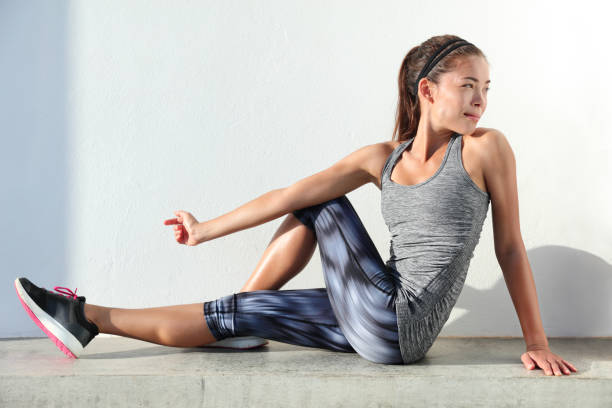Workouts
What Is The Best Exercise For Hip Pain
Hip pain is a painful and unpleasant ailment that can strike people of all ages. It can be caused by a number of conditions, including arthritis, bursitis, or an injury. When suffering from hip discomfort, it is critical to locate activities that will assist relieve the pain and enhance mobility. In this article, we’ll look at the best workouts for hip discomfort.
Stretching is one of the most effective exercises for hip discomfort. Stretching can help you gain flexibility and minimize pain. The hip flexor stretch, lateral squat, and fire hydrant are some of the recommended hip discomfort stretches. These stretches can assist to release the muscles in the hip area, increasing mobility and reducing discomfort.
Strength training is another excellent workout for reducing hip discomfort. Building strength in the muscles surrounding the hip joint can assist to support it and alleviate pain. Bridges, straight leg lifts, and clamshells are some of the recommended strength training activities for hip pain. These exercises can assist to strengthen the glutes and other hip muscles, reducing pain and increasing mobility.

Understanding Hip Pain
Hip pain can be an unpleasant and debilitating illness that limits daily activities. This section will go over the causes, symptoms, and diagnosis of hip pain to help you better understand the disease.
Causes of Hip Pain
Injuries, arthritis, bursitis, and osteoarthritis are all potential causes of hip discomfort. Hip joint injuries, such as fractures, can be painful and uncomfortable. Hip discomfort is frequently caused by arthritis, a disorder characterized by joint pain and inflammation. Bursitis is another prevalent cause of hip discomfort, characterized by inflammation of the bursae, which are tiny fluid sacs that cushion and lubricate the joints. Osteoarthritis is a degenerative joint condition that causes pain and stiffness in the hip joints.
Symptoms and Diagnosis
The symptoms of hip pain vary based on the underlying cause. Common symptoms include hip, groin, or thigh discomfort, stiffness, and reduced range of motion. If you are having hip discomfort, you should consult a doctor for an accurate diagnosis. Your doctor may do a physical examination, prescribe imaging tests like X-rays or an MRI, or send you to a specialist for additional evaluation.
Finally, hip pain can be caused by a variety of factors, and the symptoms can differ depending on the underlying disease. If you are having hip discomfort, you should consult a doctor for an accurate diagnosis and treatment plan.

Effective Exercises for Hip Pain
If you have hip pain, including effective workouts into your regular routine will help relieve it and improve your range of motion. Here are some exercises to help with hip pain:
Stretching Exercises
Stretching can improve flexibility and relieve tension in the muscles that surround the hip joint. Try to incorporate these stretches into your routine:
- Hip Flexor Stretch: To stretch your hip flexors, kneel on one knee and place your other foot in front of you, bent at a 90-degree angle. Lean forward until you feel a stretch in the front of your hip. Hold for 30 seconds before swapping sides.
- Butterfly Stretch: To do the Butterfly Stretch, sit on the floor with your feet together and knees pointing to the sides. Gently press your knees into the floor until you feel a stretch in your hips. Wait 30 seconds.
- Pigeon Pose: To perform the Pigeon Pose, begin on your hands and knees. Bring one knee forward and place it behind the wrist. Straighten your other leg behind you and bring your body to the ground. Hold for 30 seconds before swapping sides.
Strength Exercises
Strengthening activities can enhance hip joint stability and lessen the likelihood of future problems. Try adding these exercises to your routine:
- Bridge: Lie on your back, knees bent, feet flat on the ground. Lift your hips to the ceiling, clenching your glutes at the peak. Lower back down and repeat 10-15 times.
- Donkey Kick: Start on your hands and knees for the Donkey Kick. Lift one leg up behind you and keep it bent at a 90-degree angle. Lower back down and repeat 10-15 times on each side.
- Single-Leg Squat: Stand on one leg and lift the other slightly off the ground. Lower yourself into a squat, maintaining your knees in line with your feet. Push back up and repeat 10-15 times on each side.
Low-Impact Aerobic Activities
Low-impact aerobic exercises can improve blood flow to the hip joint and reduce stiffness. Consider incorporating these activities into your regimen.
- Banded Walk: Wrap a resistance band around your ankles and go forward, backward, and side to side. This exercise strengthens the muscles around the hip joint.
- Swimming: Swimming is a low-impact aerobic activity that improves range of motion and reduces stiffness in hip joints.
- Cycling: Cycling is a low-impact aerobic activity that helps enhance range of motion and reduce stiffness in the hip joint.
Including stretching exercises, strength exercises, and low-impact aerobic activities in your regimen will help relieve hip discomfort and improve overall hip health.

Lifestyle and Home Remedies
Hip discomfort can be debilitating and interfere with regular activities. While exercise is beneficial to hip health, lifestyle adjustments and home remedies can help manage discomfort and promote healing.
Daily Habits for Hip Health
Incorporating good daily practices will help you avoid hip discomfort and maintain hip health. Here are some suggestions to consider:
- Rest and Ice: To minimize inflammation and pain, rest and ice the affected area. Use an ice pack for 15-20 minutes at a time, multiple times each day.
- Walking: Walking is a low-impact workout that improves hip mobility and strengthens muscles. Wearing comfortable shoes and avoiding high-impact activities can help prevent future harm.
- Standing and Sitting: Maintaining appropriate posture while standing or sitting helps alleviate stress on the hips. Avoid crossing your legs while sitting, as this might create hip misalignment.
- Sleeping: Sleep on your side with a pillow between your legs to adjust your hips and relieve pressure on the problematic area.
Pain Management at Home
In addition to healthy behaviors, there are certain home treatments that can aid with hip discomfort. Here are some choices to consider:
- Hip Muscle Stretches: Stretching the hip muscles can relieve pain and increase mobility. Try stretching your hip flexors, piriformis, and hamstrings.
- Physical Therapy: Physical therapy helps increase hip strength and flexibility. A physical therapist can create a personalized fitness regimen to meet your individual requirements.
- Resistance Band Exercises: Resistance band exercises can strengthen hip muscles and increase mobility. Try side leg raises, clamshells, and seated hip abduction.
Overall, adopting healthy habits and using home remedies can help manage hip discomfort and encourage healing. However, it is critical to contact with a healthcare practitioner before beginning any workout or therapy regimen.

When to Seek Professional Help
If you have hip discomfort, seek expert care if it persists or worsens. Hip discomfort might be a sign of a more serious underlying disease that necessitates medical attention.
Consulting a Physical Therapist
If you are suffering hip pain, it may be beneficial to see a physical therapist. A physical therapist can assist you in determining the underlying cause of your pain and developing a treatment plan to alleviate it. They can also give you exercises and stretches to aid with your problems.
Medical Interventions
If your hip discomfort is severe or persistent, you may need to seek medical help. In some circumstances, joint pain may necessitate surgical intervention, such as a hip replacement.
If you have any of the following symptoms, you should see a doctor or a healthcare practitioner.
- Severe or persistent hip pain
- Difficulty walking or standing
- Stiffness or limited range of motion in the hip joint
- Pain that worsens with activity or at night
Finally, if you are having hip discomfort, you should get professional advice to determine the underlying cause and devise an effective treatment strategy. Whether you see a physical therapist or seek medical attention, addressing hip discomfort early can help prevent additional injury and improve your overall quality of life.
Conclusion
Engaging in exercises that prioritize strengthening the muscles surrounding the hip joint has been another crucial aspect of my journey. Building a foundation of strength in the hip abductors, adductors, and gluteal muscles has provided much-needed support to the joint, contributing to improved stability and reduced strain.
Mindful practices such as yoga and tai chi have woven seamlessly into my exercise routine, offering a holistic approach to hip pain management. The deliberate and flowing movements inherent in these practices not only enhance physical flexibility but also cultivate a sense of balance and harmony, addressing both the physical and mental dimensions of well-being.
Recognizing that every individual’s experience with hip pain is unique, I’ve curated an exercise routine tailored to my specific needs, preferences, and limitations. The journey has not only been about finding the right exercises but also about cultivating a mindful and intuitive connection with my body.
Journey of self discovery


